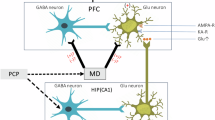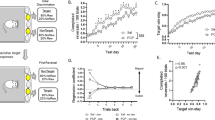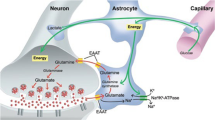Abstract
N-methyl-D-aspartate (NMDA) receptors may play a critical role in the pathophysiology of schizophrenia. In rodents, NMDA receptor antagonists, such as phencyclidine (PCP), induce dopaminergic dysregulation that resembles the pattern observed in schizophrenia. The present study investigates the degree to which concurrent treatment with NMDA modulators, such as glycine and the recently developed glycine transport antagonist N[3-(4″-fluorophenyl)-3-(4″-phenylphenoxy)propyl]sarcosine (NFPS) prevents dopaminergic dysregulation observed following chronic (3 months) or subchronic (2 weeks) PCP administration. Both chronic and subchronic treatment with PCP in the absence of glycine or NFPS led to significant potentiation of amphetamine-induced dopamine release in the prefrontal cortex and striatum, similar to that observed in schizophrenia. Treatment with either high-dose glycine or NFPS along with PCP prevented PCP effects. These findings demonstrate effective doses of glycine for use in animal models of schizophrenia, and support recent clinical studies showing the effectiveness of NMDA agonists in the treatment of persistent symptoms of schizophrenia.
Similar content being viewed by others
Log in or create a free account to read this content
Gain free access to this article, as well as selected content from this journal and more on nature.com
or
References
Abi-Dargham A, Gil R, Krystal J, Baldwin RM, Seibyl JP, Bowers M et al (1998). Increased striatal dopamine transmission in schizophrenia: confirmation in a second cohort. Am J Psychiatry 155: 761–767.
Adler CM, Goldberg TE, Malhotra AK, Pickar D, Breier A (1998). Effects of ketamine on thought disorder, working memory, and semantic memory in healthy volunteers. Biol Psychiatry 43: 811–816.
Atkinson BN, Bell SC, De Vivo M, Kowalski LR, Lechner SM, Ognyanov VI et al (2001). ALX 5407: a potent, selective inhibitor of the hGlyT1 glycine transporter. Mol Pharmacol 60: 1414–1420.
Bailey DN, Guba JJ (1980). Measurement of phencyclidine in saliva. J Anal Toxicol 4: 311–313.
Balla A, Hashim A, Burch S, Javitt DC, Lajtha A, Sershen H (2001a). Phencyclidine-induced dysregulation of dopamine response to amphetamine in prefrontal cortex and striatum. Neurochem Res 26: 1001–1006.
Balla A, Koneru R, Smiley J, Sershen H, Javitt DC (2001b). Continuous phencyclidine treatment induces schizophrenia-like hyperreactivity of striatal dopamine release. Neuropsychopharmacology 25: 157–164.
Balla A, Sershen H, Serra M, Koneru R, Javitt DC (2003). Subchronic continuous phencyclidine administration potentiates amphetamine-induced frontal cortex dopamine release. Neuropsychopharmacology 28: 34–44.
Bergeron R, Meyer TM, Coyle JT, Greene RW (1998). Modulation of N-methyl-D-aspartate receptor function by glycine transport. Proc Natl Acad Sci USA 95: 15730–15734.
Breier A, Adler CM, Weisenfeld N, Su TP, Elman I, Picken L et al (1998). Effects of NMDA antagonism on striatal dopamine release in healthy subjects: application of a novel PET approach. Synapse 29: 142–147.
Breier A, Su TP, Saunders R, Carson RE, Kolachana BS, de Bartolomeis A et al (1997). Schizophrenia is associated with elevated amphetamine-induced synaptic dopamine concentrations: evidence from a novel positron emission tomography method. Proc Natl Acad Sci USA 94: 2569–2574.
Burke TF, Buzzard S, Wessinger WD (1995). [3H]MK-801 binding to well-washed rat brain membranes following cessation of chronic phencyclidine treatment. Pharmacol Biochem Behav 51: 435–438.
Carone FA, Ganote CE (1975). D-Serine nephrotoxicity. The nature of proteinuria, glucosuria, and aminoaciduria in acute tubular necrosis. Arch Pathol 99: 658–662.
Chen L, Yang CR (2002). Interaction of dopamine D1 and NMDA receptors mediates acute clozapine potentiation of glutamate EPSPs in rat prefrontal cortex. J Neurophysiol 87: 2324–2336.
Contreras PC (1990). D-Serine antagonized phencyclidine- and MK-801-induced stereotyped behavior and ataxia. Neuropharmacology 29: 291–293.
Coyle JT (1996). The glutamatergic dysfunction hypothesis for schizophrenia. Harvard Rev Psychiatry 3: 241–253.
Daniel DG, Weinberger DR, Jones DW, Zigun JR, Coppola R, Handel S et al (1991). The effect of amphetamine on regional cerebral blood flow during cognitive activation in schizophrenia. J Neurosci 11: 1907–1917.
Davis KL, Kahn RS, Ko GN, Davidson M (1991). Dopamine in schizophrenia: a review and reconceptualization. Am J Psychiatry 148: 1474–1486.
D'Souza DC, Gil R, Cassello K, Morrissey K, Abi-Saab D, White J et al (2000). IV glycine and oral D-cycloserine effects on plasma and CSF amino acids in healthy humans. Biol Psychiatry 47: 450–462.
Elliott R, Sahakian BJ, Matthews K, Bannerjea A, Rimmer J, Robbins TW (1997). Effects of methylphenidate on spatial working memory and planning in healthy young adults. Psychopharmacology (Berlin) 131: 196–206.
Floresco SB, Todd CL, Grace AA (2001). Glutamatergic afferents from the hippocampus to the nucleus accumbens regulate activity of ventral tegmental area dopamine neurons. J Neurosci 21: 4915–4922.
Goff DC, Tsai G, Levitt J, Amico E, Manoach D, Schoenfeld DA et al (1999). A placebo-controlled trial of D-cycloserine added to conventional neuroleptics in patients with schizophrenia. Arch Gen Psychiatry 56: 21–27.
Goldberg TE, Bigelow LB, Weinberger DR, Daniel DG, Kleinman JE (1991). Cognitive and behavioral effects of the coadministration of dextroamphetamine and haloperidol in schizophrenia. Am J Psychiatry 148: 78–84.
Herdon HJ, Godfrey FM, Brown AM, Coulton S, Evans JR, Cairns WJ (2001). Pharmacological assessment of the role of the glycine transporter GlyT-1 in mediating high-affinity glycine uptake by rat cerebral cortex and cerebellum synaptosomes. Neuropharmacology 41: 88–96.
Heresco-Levy U, Javitt DC, Ermilov M, Lichtenberg P, Bar G (2003). High dose glycine added to olanzapine and risperidone for the treatment of schizophrenia. Biol Psychiatry, in press.
Heresco-Levy U, Javitt DC, Ermilov M, Mordel C, Silipo G, Lichtenstein M (1999). Efficacy of high-dose glycine in the treatment of enduring negative symptoms of schizophrenia. Arch Gen Psychiatry 56: 29–36.
Javitt DC (2002). Glycine modulators in schizophrenia. Curr Opin Investig Drugs 3: 1067–1072.
Javitt DC, Balla A, Sershen H, Lajtha A (1999). A.E. Bennett Research Award. Reversal of phencyclidine-induced effects by glycine and glycine transport inhibitors. Biol Psychiatry 45: 668–679.
Javitt DC, Frusciante M (1997). Glycyldodecylamide, a phencyclidine behavioral antagonist, blocks cortical glycine uptake: implications for schizophrenia and substance abuse. Psychopharmacol 129: 96–98.
Javitt DC, Jotkowitz A, Sircar R, Zukin SR (1987). Non-competitive regulation of phencyclidine/sigma-receptors by the N-methyl-D-aspartate receptor antagonist D-(-)-2-amino-5-phosphonovaleric acid. Neurosci Lett 78: 193–198.
Javitt DC, Silipo G, Cienfuegos A, Shelley AM, Bark N, Park M et al (2001). Adjunctive high-dose glycine in the treatment of schizophrenia. Int J Neuropsychopharmacol 4: 385–392.
Javitt DC, Zukin SR (1990). The role of excitatory amino acids in neuropsychiatric illness. J Neuropsychiatry Clin Neurosci 2: 44–52.
Javitt DC, Zukin SR (1991). Recent advances in the phencyclidine model of schizophrenia. Am J Psychiatry 148: 1301–1308.
Javitt DC, Zylberman I, Zukin SR, Heresco-Levy U, Lindenmayer JP (1994). Amelioration of negative symptoms in schizophrenia by glycine. Am J Psychiatry 151: 1234–1236.
Jentsch JD, Redmond Jr DE, Elsworth JD, Taylor JR, Youngren KD, Roth RH (1997). Enduring cognitive deficits and cortical dopamine dysfunction in monkeys after long-term administration of phencyclidine. Science 277: 953–955.
Jentsch JD, Taylor JR, Elsworth JD, Redmond Jr DE, Roth RH (1999). Altered frontal cortical dopaminergic transmission in monkeys after subchronic phencyclidine exposure: involvement in frontostriatal cognitive deficits. Neuroscience 90: 823–832.
Jentsch JD, Taylor JR, Roth RH (1998). Subchronic phencyclidine administration increases mesolimbic dopaminergic system responsivity and augments stress- and psychostimulant-induced hyperlocomotion. Neuropsychopharmacology 19: 105–113.
Johnson KM, Phillips M, Wang C, Kevetter GA (1998). Chronic phencyclidine induces behavioral sensitization and apoptotic cell death in the olfactory and piriform cortex. J Neurosci Res 52: 709–722.
Kegeles LS, Abi-Dargham A, Zea-Ponce Y, Rodenhiser-Hill J, Mann JJ, Van Heertum RL et al (2000). Modulation of amphetamine-induced striatal dopamine release by ketamine in humans: implications for schizophrenia. Biol Psychiatry 48: 627–640.
Kegeles LS, Zea-Ponce Y, Abi-Dargham A, Rodenhiser J, Wang T, Weiss R et al (1999). Stability of [123I]IBZM SPECT measurement of amphetamine-induced striatal dopamine release in humans [In Process Citation]. Synapse 31: 302–308.
Krystal JH, Bennett A, Abi-Saab D, Belger A, Karper LP, D'Souza DC et al (2000). Dissociation of ketamine effects on rule acquisition and rule implementation: possible relevance to NMDA receptor contributions to executive cognitive functions. Biol Psychiatry 47: 137–143.
Krystal JH, Karper LP, Seibyl JP, Freeman GK, Delaney R, Bremner JD et al (1994). Subanesthetic effects of the noncompetitive NMDA antagonist, ketamine, in humans. Psychotomimetic, perceptual, cognitive, and neuroendocrine responses. Arch Gen Psychiatry 51: 199–214.
Laruelle M (1998). Imaging dopamine transmission in schizophrenia. A review and meta-analysis. Q J Nucl Med 42: 211–221.
Laruelle M, Abi-Dargham A, Gil R, Kegeles LS, Innis R (1999). Increased dopamine transmission in schizophrenia: relationship to illness phases. Biol Psychiatry 46: 56–72.
Laruelle M, Abi-Dargham A, van Dyck CH, Gil R, D'Souza CD, Erdos J et al (1996). Single photon emission computerized tomography imaging of amphetamine- induced dopamine release in drug-free schizophrenic subjects. Proc Natl Acad Sci USA 93: 9235–9240.
Laruelle M, Abi-Dargham A, van Dyck CH, Rosenblatt W, Zea-Ponce Y, Zoghbi SS et al (1995). SPECT imaging of striatal dopamine release after amphetamine challenge. J Nucl Med 36: 1182–1190.
Laruelle M, D'Souza CD, Baldwin RM, Abi-Dargham A, Kanes SJ, Fingado CL et al (1997a). Imaging D2 receptor occupancy by endogenous dopamine in humans. Neuropsychopharmacology 17: 162–174.
Laruelle M, Iyer RN, al-Tikriti MS, Zea-Ponce Y, Malison R, Zoghbi SS et al (1997b). Microdialysis and SPECT measurements of amphetamine-induced dopamine release in nonhuman primates. Synapse 25: 1–14.
Leiderman E, Zylberman I, Zukin SR, Cooper TB, Javitt DC (1996). Preliminary investigation of high-dose oral glycine on serum levels and negative symptoms in schizophrenia: an open-label trial. Biol Psychiatry 39: 213–215.
Mehta MA, Owen AM, Sahakian BJ, Mavaddat N, Pickard JD, Robbins TW (2000). Methylphenidate enhances working memory by modulating discrete frontal and parietal lobe regions in the human brain. J Neurosci 20: RC65.
Meyer JS, Greifenstein F, DeVault M (1959). A new drug causing symptoms of sensory deprivation. J Nerv Ment Dis 129: 54–61.
Miller DW, Abercrombie ED (1996). Effects of MK-801 on spontaneous and amphetamine-stimulated dopamine release in striatum measured with in vivo microdialysis in awake rats. Brain Res Bull 40: 57–62.
Miyamoto Y, Yamada K, Noda Y, Mori H, Mishina M, Nabeshima T (2001). Hyperfunction of dopaminergic and serotonergic neuronal systems in mice lacking the NMDA receptor epsilon1 subunit. J Neurosci 21: 750–757.
Moore H, West AR, Grace AA (1999). The regulation of forebrain dopamine transmission: relevance to the pathophysiology and psychopathology of schizophrenia. Biol Psychiatry 46: 40–55.
Newcomer JW, Farber NB, Jevtovic-Todorovic V, Selke G, Melson AK, Hershey T et al (1999). Ketamine-induced NMDA receptor hypofunction as a model of memory impairment and psychosis. Neuropsychopharmacology 20: 106–118.
Nilsson M, Carlsson A, Carlsson ML (1997). Glycine and D-Serine decrease MK-801-induced hyperactivity in mice. J Neural Transm 104: 1195–1205.
Paxinos G, Watson C (1998). The Rat Brain in Stereotaxic Coordinates. Academic Press: Sydney.
Proksch JW, Gentry WB, Owens SM (2000). The effect of rate of drug administration on the extent and time course of phencyclidine distribution in rat brain, testis, and serum. Drug Metab Dispos 28: 742–747.
Scott L, Kruse MS, Forssberg H, Brismar H, Greengard P, Aperia A (2002). Selective up-regulation of dopamine D1 receptors in dendritic spines by NMDA receptor activation. Proc Natl Acad Sci USA 99: 1661–1664.
Shoham S, Javitt DC, Heresco-Levy U (1999). High dose glycine nutrition affects glial cell morphology in rat hippocampus and cerebellum. Int J Neuropsychopharmacol 2: 35–40.
Shoham S, Javitt DC, Heresco-Levy U (2001). Chronic high-dose glycine nutrition: effects on rat brain cell morphology. Biol Psychiatry 49: 876–885.
Svensson TH (2000). Dysfunctional brain dopamine systems induced by psychotomimetic NMDA-receptor antagonists and the effects of antipsychotic drugs. Brain Res Brain Res Rev 31: 320–329.
Szeszko PR, Bilder RM, Dunlop JA, Walder DJ, Lieberman JA (1999). Longitudinal assessment of methylphenidate effects on oral word production and symptoms in first-episode schizophrenia at acute and stabilized phases. Biol Psychiatry 45: 680–686.
Toth E, Lajtha A (1986). Antagonism of phencyclidine-induced hyperactivity by glycine in mice. Neurochem Res 11: 393–400.
Tsai G, Yang P, Chung LC, Lange N, Coyle JT (1998). D-Serine added to antipsychotics for the treatment of schizophrenia. Biol Psychiatry 44: 1081–1089.
Umbricht D, Schmid L, Koller R, Vollenweider FX, Hell D, Javitt DC (2000). Ketamine-induced deficits in auditory and visual context-dependent processing in healthy volunteers: implications for models of cognitive deficits in schizophrenia. Arch Gen Psychiatry 57: 1139–1147.
Wang J, O'Donnell P (2001). D(1) dopamine receptors potentiate NMDA-mediated excitability increase in layer V prefrontal cortical pyramidal neurons. Cereb Cortex 11: 452–462.
Yurgelun-Todd DA, Waternaux CM, Cohen BM, Gruber SA, English CD, Renshaw PF (1996). Functional magnetic resonance imaging of schizophrenic patients and comparison subjects during word production. Am J Psychiatry 153: 200–205.
Acknowledgements
This paper was supported in part by USPHS Grants R01 DA03383 and K02 MH01439 to DC, and the Burroughs Wellcome Fund. NFPS was provided for research use by NPS-Pharmaceuticals (Mississauga, Ontario, Canada).
Author information
Authors and Affiliations
Corresponding author
Rights and permissions
About this article
Cite this article
Javitt, D., Balla, A., Burch, S. et al. Reversal of Phencyclidine-Induced Dopaminergic Dysregulation by N-Methyl-D-Aspartate Receptor/Glycine-site Agonists. Neuropsychopharmacol 29, 300–307 (2004). https://doi.org/10.1038/sj.npp.1300313
Received:
Revised:
Accepted:
Published:
Issue date:
DOI: https://doi.org/10.1038/sj.npp.1300313
Keywords
This article is cited by
-
Heritability of cerebral glutamate levels and their association with schizophrenia spectrum disorders: a 1[H]-spectroscopy twin study
Neuropsychopharmacology (2019)
-
Rodent Mismatch Negativity/theta Neuro-Oscillatory Response as a Translational Neurophysiological Biomarker for N-Methyl-D-Aspartate Receptor-Based New Treatment Development in Schizophrenia
Neuropsychopharmacology (2018)
-
Association of schizophrenia onset age and white matter integrity with treatment effect of D-cycloserine: a randomized placebo-controlled double-blind crossover study
BMC Psychiatry (2017)
-
Managing Negative Symptoms of Schizophrenia: How Far Have We Come?
CNS Drugs (2017)
-
Modulating NMDA Receptor Function with d-Amino Acid Oxidase Inhibitors: Understanding Functional Activity in PCP-Treated Mouse Model
Neurochemical Research (2016)



